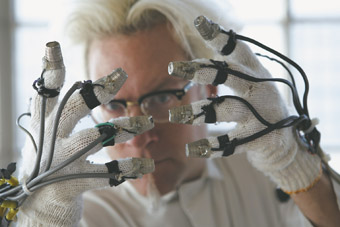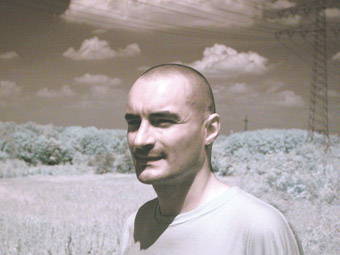sounds continuous
gail priest: nat bates, liquid architecture 10

Marc Gunderson, The Evolution Control Committee
photo Brooke Buchanon
Marc Gunderson, The Evolution Control Committee
IN 1999 A GROUP OF RMIT STUDENTS PRESENTED A COLLECTION OF EXPERIMENTAL SOUND AND MUSIC EVENTS. TEN YEARS ON, THIS COLLECTION OF EVENTS, LIQUID ARCHITECTURE, HAS GROWN INTO ONE OF AUSTRALIA’S MOST SIGNIFICANT FESTIVALS WITH A NATIONAL TOURING PROGRAM OF CONCERTS, INSTALLATIONS AND FORUMS.
While there have been many contributing directors and collaborators, Nat Bates has been the mainstay for the entire decade. This heroic effort has allowed for consistency in both the quality and curatorial approach, however Bates is keen to point out that each Liquid Architecture is never purely his vision. “One of the key things for me is the team of curators. When we were a Melbourne only event there were a number of people I worked with [Bruce Mowson was co-director 2001-4, Camilla Hannan 2001-2] and now that it’s a national event I rely heavily upon the people in the other cities for input. That keeps it fresh and interesting, keeps me motivated, keeps me in touch with things that I’m missing. I’d feel very uncomfortable if it was purely my thing.”
Liquid Architecture started up a few years after What is Music? began challenging our senses. Over the last decade several other important festivals have also entered the landscape, including The NOW now. However Liquid Architecture has managed to maintain its own distinctive emphasis on national and international guests who offer historical perspectives on contemporary practices. Bates recollects that “in 1999, 2000, there was a lot of talk about new media but as a student I was learning that it wasn’t new, that there’s a history. So I was very keen to highlight established artists, who’d been working for a long time, alongside emerging artists. I think the festival has tried to do that continuously, whether it’s an international guest who has never been to Australia before and who has a decades-long career, or some particular practice or way of working that we want to highlight…This is tied in with the fact that the practices we’ve highlighted are still ongoing in some way. I’m not interested in doing retrospectives as such. So when Tony Conrad came out, he was still developing what he was doing in the 60s—it’s a living practice. It’s up to him whether he wants to play old works or present contemporary ones.”
Within this framework, the festival has always been diverse, covering a wide range of approaches to sound and music making. I asked Bates how this has worked for the event. “It’s been a struggle over the 10 years trying to establish a profile for the festival and to explain what it is. People wanted to pin ‘electronic music festival’ on us in the beginning and I was very reluctant to do that. We adopted the ‘sound arts’ label early on, which was contentious and difficult as well because there’s a lot of different understandings of what that is. Then we struck upon the idea of calling it a ‘sense-specific’ festival…The diversity in the programming is definitely a reflection of all the things that are going on, and not wanting to be narrowed down to a genre or particular area of practice. But it’s also a recognition that Australia has a small population—artistic communities are relatively small in number but we wanted to be broader than that and bring in as many communities as possible.”
What is unique about Liquid Architecture is the way the touring model has grown. The interstate elements of the festival are run by local directors who program their own concert series and events drawing on the international guests and adding locals into the mix. This year as well as Melbourne, Sydney, Brisbane and Perth, the festival will go to Castlemaine and Bendigo in regional Victoria, and Cairns in far north Queensland.” The truth is,” says Bates, “there’s got to be people interested [in this music] in all these places. Just because they live somewhere rural doesn’t mean that they’re not interested in things that happen mostly in the big cities. Part of the motivation for the festival is to provide opportunities for artists they wouldn’t get otherwise—to tour this kind of music and to play to audiences outside of the capital cities.”
I asked Bates to pick out a few highlights from the last 10 years of Liquid Architecture. Even though, like a proud father, he was reluctant to play favourites, he did cite a particular moment. “My number one highlight was Bernard Parmegiani playing in Melbourne, doing a speaker orchestra event, which is an area of personal interest to me. I never thought I’d get to see something that happens exclusively in Europe. It was amazing to meet him.”
It’s this meaningful connection with key artists that has kept Bates—an artist himself, like most promoters and organisers in this sector—forging ahead, despite the time it takes away from his own practice. “If I’m organising a show I get a real connection with [the artists]. First of all we have to talk about technical things: what gear do you need; how does this work; how do we orientate the space; how do we get an audience; how do we promote it. Just starting those conversations, it becomes a deeper artistic collaboration in a way.”
Liquid Architecture has previously operated under the auspices of RMIT, however it is now in the process of establishing itself as a separate legal entity. I asked Bates about the effect this is having on the future of the festival. “[In] some ways [the change] is motivated by asking how can we sustain what we’re doing, but it’s also raised the question of whether we should continue doing what we’re doing—should we be doing it differently? This is a very healthy thing but it does mean that there’s some uncertainty about whether or not the festival will continue in its current shape and form. But it’s got a very healthy base to build on and there are some things you just don’t throw out…Personally I wanted to start to formalise the informal ways that I’ve been working for 10 years in terms of the mentoring and advice that I get from various people…I’ve always relied on other people’s opinions. The Melbourne program is very much a collaborative effort. Local organisers and curators come to me saying ‘I want to do a series of shows, Can one of these be part of the festival and how can we fit them together?’ So I’m interested in formalising these making it clearer how we all work together.”
So what does the 10th Liquid Architecture have in store for us? Thanks to a partnership with the Goethe Institut, there is a strong German contingent. Asmus Tietchens offers the program’s historical context—his career started in 1965. With around 20 releases to his name, Tietchens remains an understated figure in the experimental landscape because his work does not adhere to any particular style or movement but instead is “simply the musical exploration of the studio, idea, or collaborative situation at that given time.” Particularly intriguing is the duo Kontakt der Jünglinge, which is Tietchens and another German guest, Thomas Köner, a renowned audiovisual artist with Golden Nica and Transmediale awards under his belt, who will also be playing solo sets. Also from Germany is Perlonex featuring Ignaz Schick (live-electronics), Jörg Maria Zeger (guitars) and Burkhard Beins (percussion) exploring the electroacoustic spectrum.

Thomas Köner
courtesy the artist
Thomas Köner
From the US comes The Evolution Control Committee led by Marc Gunderson (aka TradeMark G), plundering other people’s music to create whole new works and sticking it to the upholders of pesky things like copyright. Gunderson is credited with inventing the MashUp, in which two songs are slammed into each with surprising ramifactions. He is also credited with inventing the term ‘plagiarhythm’, which has made it into the dictionary and, through his software tinkerings, has created a musical interface, the Thimbletron.
Liquid Architecture has always featured exhibition elements and this year each of the major venues has something on offer. At the Brisbane Powerhouse there’s an exhibition by Eugene Carchesio and San Francisco-based media artist Scott Arford. Arford will also present work alongside Ruark Lewis, Vicky Browne, Lauren Brincat and the UTS instigated Memory Flows group at Performance Space, Sydney. Bendigo will present audiovisual installations by the Undue Noise Collective and Jacques Soddell. In Melbourne, WestSpace offers experimental instruments and installations by Alan Lamb, Dale Gorfinkel, Rosalind Hall and Peter Blamey along with Location Sound Films by Estonian artist John Grzinich. At Arts House, North Melbourne Town Hall, US/Swiss artist Jason Kahn will present Brown White Blue Pink, an installation using 4-channel audio disseminated over 40 two-inch speakers to explore the four colours of noise.
To have achieved a decade of consistent operation in the experimental music landscape is truly a remarkable achievement. With events across seven cities in 19 days for Liquid Architecture 10, it appears that enthusiasm from organisers, artists and audiences is strong and still growing and should do for another decade.
Liquid Architecture 10, national artistic and Melbourne director Nat Bates; Sydney, co-directors Shannon O’Neill, Jennifer Teo, June 24-27; Brisbane, director Lawrence English, July 3-4; Castlemaine, presented by ICU/Punctum, July 5; Perth, presented by Tura New Music, July 7; Bendigo, director Jacques Soddell, July 8-9, 23; Melbourne July 9-12; Cairns, presented by On Edge 09, July 12; www.liquidarchitecture.org.au
RealTime issue #91 June-July 2009 pg. 46






